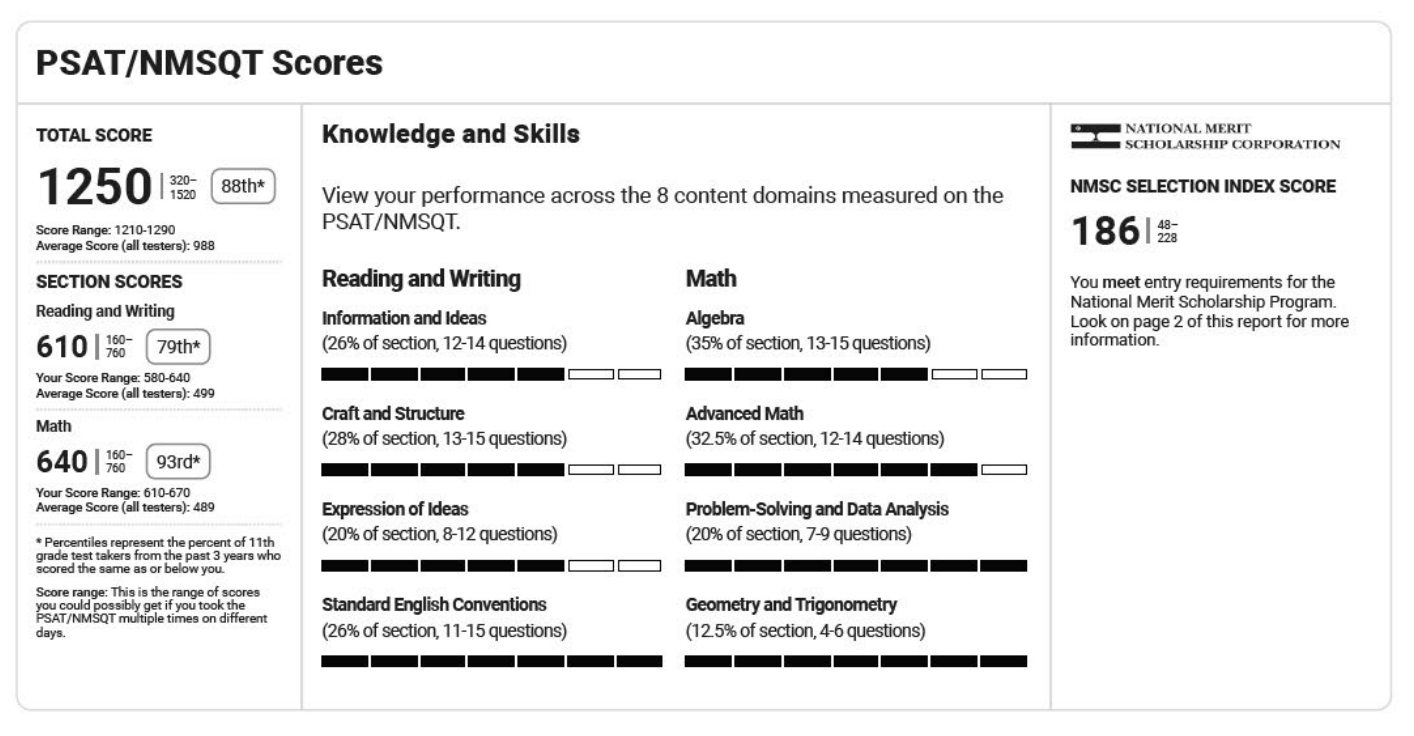1. First off, take a deep breath!
2. Your Score
Your Total Score, the number on the top left of the score report, is a combination of your Reading and Writing and Math scores. Underneath, you’ll see the section score breakdown. Don’t be surprised if one is much higher or lower than the other. Many students start the test prep process this way and Carnegie Prep’s curriculum is designed to address both subject matters.

For a complete breakdown of the PSAT score report, including percentiles, answer key, and scaled scores read click here.
3. Get Online!
When your PSAT score report is ready, you will get an email from the College Board.
Step 1: In order to view your report, you must create a College Board account. If you do not already have a College Board account, click here to create a College Board Account for the first time.
Do not create a new College Board account if you already have one. If you’ve forgotten which email address you provided or have other technical difficulties, contact College Board customer service at 866-315-6068 or visit their Creating and Managing Your Account page.
Step 2: Access your online PSAT score report.
You can also link your College Board account to the BigFuture School Mobile App to access your scores and get information about colleges, scholarships, financial aid, and potential career opportunities.
4. The Range
Once you open the Report Details section, you will see a range of scores for the Reading and Writing and Math sections. It’s an initial approximation by the College Board of how you might do on the SAT.
These numbers suggest the range that you might achieve on the actual test with little or no prep. They are a baseline and not a reflection of your score potential. That said, they can help you identify your goals.
Progress on standardized tests is all about taking one step at a time, prepping smart, and a plethora of patience. Allow enough time for your testing plan to unfold.
5. Your Percentile
Percentiles represent the percent of 11th grade test takers from the past 3 years who scored the same as or below you.
6. Knowledge and Skills
Now move on to the Knowledge and Skills section of your score report. You will see a graphic that shows your performance on each of the eight content areas measured on the PSAT/NMSQT – four in each section.
| Reading and Writing Content Areas | Math Content Areas |
|
|
For each content area, you’ll see:
These numbers will give you an early indication of your strengths and weaknesses. This is vital information as you develop your testing plan and you’ll want to share this information with your tutor or teachers.
7. Scholarships and Your NMSC Selection Index
PSAT scores can allow students to qualify for a number of scholarships and recognition programs that are often related to a student’s background or other involvements. Additionally, the College Board uses junior-year PSAT scores to qualify students for National Merit Scholarships.
If your number on the selection index is above your state’s cutoff (which changes every year), you may qualify for different levels of honors and scholarships. If you have ever heard of someone being awarded a National Merit Scholarship, this is the first step towards that distinction.
Cutoffs for boarding school students are determined regionally as opposed to at the state level. For example, a student attending a boarding school in the Northeast must meet the highest cutoff of any state within the Northeast region.
Students who are homeschooled are treated like any other students in their state. Meanwhile, U.S. students studying abroad have to meet the highest state cutoff in the country.
Below are the National Merit Semifinalist and Commended Student cutoffs for recent years.
To calculate your Selection Index, take your section scores (scored 160-760) and:
- Drop the final zero in your scores
- Double your Reading and Writing score
- Add your Math score
If your score doesn’t make the cutoff, don’t sweat it. Focus on building a great testing plan and go on with your life.
| State | Class of 2024 | Class of 2023 | Class of 2022 | Class of 2021 | Class of 2020 | Class of 2019 |
| Connecticut | 221 | 221 | 220 | 220 | 221 | 222 |
| New York | 220 | 219 | 220 | 220 | 221 | 221 |
| Commended Student | 207 | 207 | 207 | 209 | 212 | 212 |
8. Plan your Prep
At Carnegie Prep, we are experts on customizing testing plans. Whether you’re looking for a long-term game plan or just a chance to bounce some questions off of our incredible tutors and teachers, we can help!
To create your best testing plan, email us or call us at (203) 352-3500.


